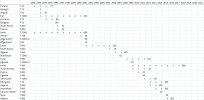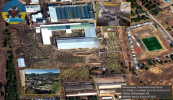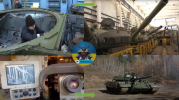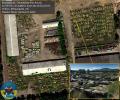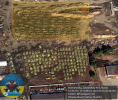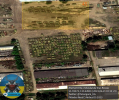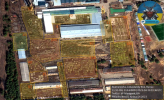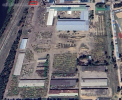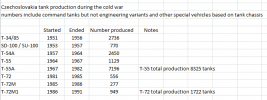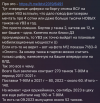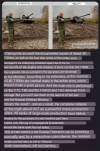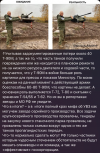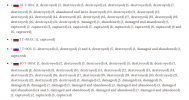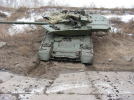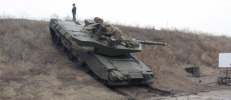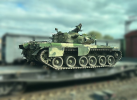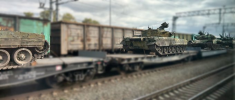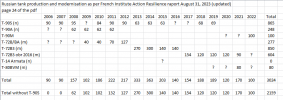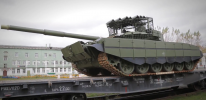Alexey Khlopotov kirjoittama artikkeli "T-90 main battle tank of Russia", julkaistu venäläisessä lehdessä nimeltä Техника и Вооружение (eng. Equipment and weapons) sen numerossa 5/2010. Artikkeli löytyy lehden sivuilta 2-9.
Tämä on konekäännös joten käännöskukkaset ja -virheet ovat mahdollisia.
-
Equipment and weapons yesterday, today, tomorrow
Alexey Khlopotov
T-90
MAIN BATTLE TANK OF RUSSIA
Photos used from the archives of the editorial office and OAO UKBTM.
"T-90" is probably the most "promoted" brand of the Russian defense industry. Along with the S-300 air defense system and superfighters of the Sukhoi family, this tank has become the hallmark of the Russian military-industrial complex. The pages of print and electronic media are full of references to it, even a certain genre of publications has appeared, where a Russian tank is compared with vehicles from other manufacturers. However, how correct are such comparisons? A lot of it depends on what you compare it to. Many people forget that the T-90 tank will soon be 20 years old! During this time, many serious changes have been made to its design, it has acquired many modifications and submodifications. Thus, for an objective comparison, it is first necessary to figure out what it is - the “Main Battle Tank T-90”?
The beginning of work on the design of this tank falls on 1986. By the mid-1980s the military power of the USSR was in its prime, but it was necessary to think about the short-term prospects for the development of BTT, especially since there were no reasons for complacency. The fleet of T-64 tanks, due to the design features of the vehicle, became obsolete and was not subject to modernization. The T-80 with gas turbine engines was, even by Soviet standards, very expensive to manufacture and operate, and therefore had no prospects of becoming a mass machine. Modification of the T-80 with a two-stroke diesel engine - T-80UD, although it was cheaper, but distinguished by unreliability and capriciousness of the power plant. Its adoption in 1985 led to an even greater disunification of the tank fleet. At the same time, the most massive tank of the USSR -T-72- was a variant of the vehicle for the mobilization period, and therefore was extremely simplified for mass production and operation, poorly trained with a cadre of reservists, although it was distinguished by great reliability and maintainability.
The weak point of the machines of the T-72 family was an extremely simplified FCS, which, in principle, could not be called a fire control system. According to this parameter, the newly adopted T-72B was clearly inferior to modern modifications of the T-64B, and even more so the T-80U. The logical way out of this situation suggested itself: constructively cross the simple but reliable T-72 with the “intelligent” but expensive T-80. In the near future, such a vehicle could really become the main one in the Soviet Ground Forces, gradually replacing tanks of other types. The decision was obvious, but extremely difficult, especially from a political point of view. Competition within the country between the three main developers of tanks has not weakened over time. Nizhny Tagil Uralvagonzavod and UKBTM needed a lot of effort to "break through" the government's decision on a deep modernization of the T-72 tank.
On June 19, 1986, by a decree of the Council of Ministers of the USSR, the Ural Design Bureau of Transport Engineering in cooperation with a number of industry research institutes and design bureaus, development work was assigned on the topic “Improvement of the T-72B”. As a whole, the head of the R&D was the Deputy Chief Designer of UKBTM N.A. Molodnyakov. V.A. Gudkov and V.I. Bundin [1]. Having kept the layout solutions of the T-72B unchanged, the designers focused their main efforts on adapting the KUO 1A45 of the T-80U tank to the T-72B, on increasing fire capabilities and security.
During this period, UKBTM underwent significant administrative changes. After 38 years of work in the design bureau (of which 18 were chief designer), Valery Nikolaevich Venediktov retired. On November 19, 1987, Vladimir Ivanovich Potkin took his place. Heir to the traditions of the Tagil design school, who graduated with honors from the academy, at UKBTM he dealt with the problems of the engine, transmission and running gear. Outwardly unsociable, withdrawn, sharp, strict and extremely demanding, for some he looked like a stern person. However, over the years, through this external severity, it was possible to discern humanity, worldly wisdom, the ability to make well-thought-out, comprehensively balanced decisions. In the most difficult years of the collapse of the country and industry, the widespread curtailment of defense work, his candidacy was the only possible one as head of the UKBTM.
The concept of creating a new model assumed, having retained the layout solutions of the T-72B, to reach a new level of technical perfection of the design in order to maximize the increase in combat characteristics. However, as in previous years, the material support for the development of the Ural Design Bureau from the Ministry of Defense Industry was very scarce. Despite the developments available in the USSR on promising management systems, Tagil residents had to be content with “what they give”. This circumstance led to special attention of designers to the parameters and characteristics of the machine, which could be improved solely by the design bureau and the serial plant without the help of large contracting contractors.
After going through several stages of development, the new machine received the index "Object 188”. In the design documentation and external official correspondence, "Object 188" was first called T-72BM ("B" modernized), and later changed its name to "T-72B improved" [2].
In January 1989, four prototypes of the "Object 188" were submitted for state tests, which lasted about a year. Based on the results of these tests, the customer determined a specific sample for further refinement and acceptance into service. From June to September 1990, two more prototypes of the new version of the tank passed the final tests. At the end of the program, one sample of the machine was shot at the training ground, and the second was returned for study and refinement to Nizhny Tagil. The result of the work carried out was a joint decision of the Ministry of Defense and the Ministry of Defense of March 27, 1991 on the recommendation to adopt the tank "Object 188" [3]. However, the political crisis and the collapse of the USSR in 1991 led to a significant delay in the delivery of the improved T-72B to service. Only on September 30, 1992, the first tank in the pilot batch entered the run tests before being handed over to the troops.
The most difficult situation in the economy of post-Soviet Russia forced UKBTM and UVZ to engage in independent survival in a new political and economic situation. In this regard, the developer and manufacturer made great efforts to make a decision on putting a new tank into service with the Russian Army. Under the influence of a political moment, in order to distance ourselves from the era of the USSR, a decision was made on a new military name, original intention was the abbreviation "T-88" [4]. June 8, 1992 UVZ was visited by the first President of Russia B.N. Yeltsin. During this visit, he promised to sign a resolution on the adoption of the T-88 tank. The proposal to name the tank "T-90" arose somewhat later and was included in the final version of the document. On October 5, 1992, by Decree of the Government of the Russian Federation No. 759-58, the Object 188 tank was adopted by the Russian armored forces as the T-90.
Simultaneously with the work on the base machine "Object 188", the design bureau was engaged in the creation of an export one - "Object 188C". A little later, work began on the commander's version - "Object 188K".
What was the new tank in technical terms? As mentioned above, the main layout solutions were left from the T-72B (“Object 188”). However, the tower was adapted for the installation of an automated fire control complex, and the hull was adapted for the installation of new protection.
The main weapon of the tank was a 125-mm D-81TM (2A46M) smooth-bore gun-launcher with improved ballistic characteristics. The external distinguishing features of the gun are the new design of the thermal protective casing and the device for quick replacement of the barrel. The D-81TM is a modification of the 2A46M-1 gun, adapted to work with the AZ-185 automatic loader and adapted to use the ejection mechanism for spent pallets. High accuracy characteristics of the gun are achieved due to the optimal combination of curvature, wall thickness and rigidity of the barrel, symmetrical arrangement of the recoil and knurling brakes, free unbraked long recoil of the barrel before the ammunition leaves it, as well as the use of a thermal protective casing. The T-90 has a built-in gun alignment device with both the main and thermal imaging sights. This device significantly increases the accuracy of the operation, reduces its time to 1 min and makes it possible to perform alignment without leaving the tank.
Ammunition for the gun includes armor-piercing sub-caliber, cumulative and high-explosive fragmentation rounds with separate case loading, as well as a guided shot [5]. Moreover, the OFS can operate with the Ainet remote detonation system to defeat the enemy’s manpower [6].
To increase the range of effective firing on the T-90, the 9K119 "Reflex" guided weapon system with 9M119 (ZUBK14 round) and 9M119M (ZUBK20 round) missiles was used. The complex is integrated into the KUO. It implements the protected semi-automatic launch only from a spot or from a short distance control system with tele-orientation of the missile in the laser beam. The complex allows effective firing at a distance of 100 to 5000 m from a standstill and on the move (at a speed of up to 30 km/h) both at stationary targets and at targets moving at a speed of up to 70 km/h, including helicopters [7]. In addition, 9K119 allows firing using a thermal imager. The ability to fire guided weapons on the move and at night is a significant innovation compared to the T-72B, where missile firing could be carried out without any stops.
As an auxiliary weapon, a 7.62 mm PKTM machine gun coaxial with a cannon with a combat rate of fire of 250 rds/min is traditionally used. and 2000 rounds of ammunition. An additional weapon is an anti-aircraft machine-gun mount. In contrast to all previously produced modifications of the T-72 tanks, the T-90 has a self-contained ZPU with remote electromechanical control. Anti-aircraft machine gun -12.7 mm NSVT "Utes". Optical sight, monocular, periscope PZU-7 with a magnification of 1.2x. The closed remote-controlled ZPU is designed to combat lightly armored ground targets, enemy manpower at a distance of up to 1600 m and protect against air attacks against targets moving at speeds up to 300 m/s [8]. Detection, tracking and firing at targets is carried out by the commander with the hatch closed commander's turret, which allows the commander to conduct effective shooting to kill, while remaining under the protection of armor. ZPU ammunition is 300 rounds.
The main innovation of the T-90 in comparison with the "seventy-two" is the presence of a full-fledged fire control system 1A45T, created by adapting the KUO 1A45 "Irtysh" of the T-80U tank to the turret and actuators of the T-72B. KUO provides the gunner day and night, from a place and on the move, to conduct aimed fire from a cannon and a machine gun coaxial with it, and to fire guided weapons. The CMS provides the commander with the search, detection and identification of targets, the issuance of target designation to the gunner, and the conduct of aimed fire from any weapon of the tank in all conditions of operation of the tank. The KUO includes: the 1A42 fire control system, the PNK-4S commander's sighting and observation system, and the gunner's thermal imaging sight.
The control system consists of a day laser rangefinder sight 1G46 with a built-in automation unit 9S517 KUV 9K119 "Reflex" and an electronic ballistic computer.
The control system consists of a 1G46 daytime laser rangefinder sight with a built-in automation unit 9S517 KUV 9K119 Reflex and an electronic ballistic computer 18528-1 with a set of sensors that allows you to automatically calculate and introduce corrections for the temperature of the charge, projectile type, range, angular velocities of the target and the tank, roll (angle of inclination of the trunnions of the gun) and the speed of the tank, the degree of wear of the gun bore, and with the help of the DV-E capacitive sensor - air temperature, atmospheric pressure and side wind speed.
The commander's sighting and observation system PNK-4S provides the commander with observation of the terrain, search and detection of a target, target designation and fire adjustment, aimed fire from a cannon and a machine gun coaxial with it in all conditions in the "Double" mode, and aimed fire from ZPU against air and ground targets. The PNK-4S includes the TKN-4S "Agat-S" device, a gun position sensor, a ZPU 1ETs29 control system with a PZU-7 sight.
Instead of the passive-active night sight of the gunner 1K13-49 (T-72B), the T-90 was equipped with a thermal imaging system, consisting of an active-passive night sight TO1-KO Buran-PA, or a thermal imaging sight TO1-PO2T "Agava-1". However, due to problems with the production of "Agave", serial T-90s of the Russian Army were equipped with "Buran" sights [9]. Agave was equipped with only two experimental machines [10]. Pointing accuracy is also ensured by a more powerful weapon stabilizer 2342-4 "Jasmine" (on the T-72B - 2342-2) [11].
The T-90 has a built-in dynamic protection complex. VDZ "Kontact V" was developed at the Moscow Research Institute of Steel and, in combination with passive combined armor, guarantees tank protection against 120-mm BPS M829 [12] and ATGMs of the HOT, MILAN-2, TOW-2 type. According to the information of the developer - the Research Institute of Steel, the KDZ of the T-90 tank provides an increase in the protection of the tank against cumulative weapons by 1.9-2.0 times, and from the defeat of the BPS - by 1.2 times. The area of the frontal projection, covered by the CDS at a heading angle of 0°, is more than 55%; at a heading angle of 20°, the hull is covered by 45%; at an angle of 35°, the turret is also covered by 45%. The total number of DZ sections is 26 pieces [13]. Of these, 8 sections are located on the tank turret, 12 sections are on the upper frontal part of the hull, and 6 sections are on the side screens. At the same time, the tower has 6 full-size V-shaped sections, one narrower V-shaped structure and one single container - such modators. same as one of the blocks that make up the V-shaped section to the left of the cannon, but inverted horizontally and attached to the turret with an inclination.
In addition to the Kontact V blocks, there are 21 remote sensing containers on the roof, specially designed to protect the roof of the tower. On-board anti-cumulative rubber-fabric screens, in addition to 6 sections of the DZ (three from each side), there are fastenings for two additional sections - one for each side. So, during tests at NII-38 in Kubinka, on the side screens of the T-90, for a short time, 4 sections of the KDZ were mounted on board. The total weight of the DZ set on the machine is 1.5 tons.
For the first time, the Shtora-1 optical-electronic suppression complex was serially installed on the T-90, which includes a system of automatic all-round visibility, detection and protection against anti-tank projectiles with laser homing heads, which automatically creates interference PTS control complexes with laser rangefinders and target designators, and an optoelectronic suppression station that protects the vehicle from being hit by guided projectiles with semi-automatic guidance systems.
To improve the efficiency of combating possible fires inside the machine, an automatic fire extinguishing system ZETs13-1 “Hoarfrost” was used. The fire-extinguishing system of 2-fold action includes 4 cylinders with fire-extinguishing mixture freon 114B2 and 13B1, and 10 optical and 5 thermal
Instead of the V-84-1 diesel engine, which was installed on the T-72B tank (the disadvantages of this engine included overheating and burnout of the exhaust manifold), the T-90 uses an improved engine of this family - V-84MS. Bellows are installed on the exhaust manifolds of this engine, which mix the exhaust gases with atmospheric air, which improved the temperature regime of the manifold. The V-84MS engines are also characterized by great reliability. For example, one of the T-90 prototypes passed the turnaround time on one engine during state tests. In addition, these diesel engines are multi-fuel and can operate on diesel fuel, gasoline and kerosene, and without loss of power. Small losses occur only when running on gasoline. During tests in Turkmenistan, the tanks covered more than 1500 km on kerosene of the Republic of Tatarstan, since there was nothing else in the district warehouses. There were no complaints about the operation of the engines [14].
The equipment for radio communication consists of a VHF radio station R-163-50U and a receiver R-163-UP.
T-90 has built-in equipment for self-digging, can work with KMT-7 or KMT-8 gauge mine sweeps. Some of the machines are equipped with plates for the installation of the TBS-86 bulldozer blade. The tank is traditionally equipped with equipment for underwater driving, thanks to which it can overcome water obstacles up to 1000 m wide and up to 5 m deep along the bottom.
It should be emphasized that the T-90 was developed on the basis of a thorough study and understanding of the tactics and strategy of using tanks in real conditions of modern combat, taking into account many years of experience in military operation of T-72 tanks in various countries of the world, as well as same results of long-term intensive testing under the most difficult conditions. The implementation of a number of design developments and measures in the T-90 with the introduction of modern and advanced technologies has provided new opportunities for conducting effective combat operations, increased operational reliability and maneuverability, and also made it possible to achieve a comprehensive increase in improvement of combat and technical characteristics by 1.5 times compared to the T-72. This is the merit of the designers of UKBTM V.I. Potkina, N.A. Molodnyakova, Yu.N. Neugebauer, V.M. Bystritsky, V.D. Tumasova, G.S. Gorseva, E.B. Babylonsky, A.D. Budilova, V.S. Vikhoreva, Yu.G. Kormiltseva, V.I. Neverova, A.G. Makeeva, G.A. Kheifits, N.A. Abramovsky, O.A. Kuraksy, N.S. Davydenkova, V.I. Vasiliev, Yu.N. Kondratieva, I.N. Baranova, V.T. Yurinova, A.G. Bogomolkina, N.N. Makarova, Yu.A. Levkovsky, G.G. Ostanina, V.I. Etmanova, V.V. Pilipchuk and many others.
The total number of T-90s produced is approximately 120, including prototypes. The first 13 vehicles ended up in various training centers, and the first tank regiment of 94 T-90 tanks was formed in the 21st Taganrog Red Banner Order of Suvorov Motorized Rifle Division of the Siberian Military District. The next unit on the T-90 was the 5th Guards Don Tank Division stationed in Buryatia: it received (tentatively) from a company to a T-90 battalion [15].
However, as a result of a sharp reduction in defense appropriations, further production of the T-90 for the Russian Armed Forces ceased. In the mid 2000s in connection with the general reform of the army, almost all the T-90s that were in Siberia were relocated to the west and entered the 2nd Guards Taman Motorized Rifle Division and training centers. At the same time, it turned out that some of the machines are in extremely poor technical condition and require immediate repair, and some were completely dismantled [16]. This happened as a result of numerous violations of the statutes and regulations on military service, poor training of both privates and officers in the 1990s, which were troubled and difficult for Russia.
T-90K - commander's variant
On the basis of the order of the State Military Industrial Commission of the USSR dated April 4, 1991, within the framework of the Sambuk R&D [17], the design bureau began designing the commander's version of the T- 90, which received the name "Object 188K" in the pilot development. The tank was designed to control subordinate units, communicate with higher commanders, as well as to conduct combat operations as part of units and subunits and flexible control of units during combat operations both day and night.
The main volume of general layout work on the commander's product was performed by the leading designer V.I. Bundin. The number of units of the fire control system and communications equipment placed on the "Object 188K" has increased significantly in comparison with the commander's version of the T-72B tank. In this regard, V.I. Bykin, serious concerns arose about the possibility of an acceptable placement of all the necessary equipment on a new product. Nevertheless, thanks to the painstaking and fruitful work carried out in the Design Bureau in the shortest possible time, this complex issue was successfully resolved.
The main general machine characteristics of the T-90K remained at the level of the basic T-90. The power plant, transmission, undercarriage, armament, observation devices, armor protection, heating system, equipment for underwater driving, self-digging and installation of a mine trawl are made the same as on the T-90 tank. Special equipment of the T-90K tank, which ensures the performance of the control function, includes: HF radio station R-163-50K, whip antennas, a set of HF antennas mounted on an 11-meter telescopic mast, tank navigation equipment TNA-4 -3, artillery compass PAB-2M, Additional electric unit AB-1-P / 28.5-V-U with a power of 1 kW.
The HF radio station is designed to provide radio communications in command networks in the frequency range of 2-30 MHz while stationary and on the move. The radio station makes it possible to carry out two-way telephone and telegraph communication, auditory and automatic reception of tone call signals, reception on a rotary antenna 4 m high at a distance of up to 50-80 km. The number of pre-prepared frequencies is 16. The design of the HF whip antenna support makes it possible to install it in an inclined position. In this position, the antenna is additionally supported by a special spring fixed on the tower. Such position of the antenna turns it into a "anti-aircraft radiation antenna". The use of a “anti-aircraft radiation antenna” is effective in organizing communications in mountainous areas. The “balance vibrator” antenna installed on the 11-meter mast in the range of 2-18 MHz guarantees a communication range up to 350 km. The radio station also provides the following modes: two-frequency simplex, standby reception with scanning over recorded frequencies, reception and transmission of an address call, reception and transmission of codegrams.
Tank navigation equipment is used to determine the location of a tank or unit on the ground, the direction of movement, and the distance to a given destination. The equipment consists of a gyro-course indicator, a control panel, a coordinator, a remote (indicator) tablet for a topographic map and provides determination of the tank coordinates with high accuracy from the path traveled without reorientation. She decides the following navigation tasks:
- automatic determination of the tank's coordinates;
- automatic determination of the directional angle of the tank;
- automatic determination of the Directional angle to the destination;
- indication of the location of the tank on the topographic map;
- automatic determination of the differences between the coordinates of the tank location and the coordinates of the destination. The compass PAB-2M is used to determine the directional angle in conditions of poor visibility and when no visible landmarks.
The generating set is an auxiliary generator installation driven by a carburetor engine and serves to power consumers during parking when the main engine is not running [18].
After completion of the tests, on the basis of the order of the Minister of Defense of June 3, 1994, the tank "Object 188K" under the symbol T-90K was adopted by the Russian Army [19].
-
Artikkelista poimittuja kuvia (osa artikkelin kuvista tässä alla):
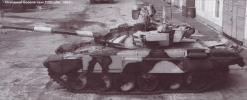
Kuvan tekstin käännös:
Main battle tank T-90 mod. 1992 / T-90 obr 1992
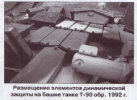
Kuvan tekstin käännös:
Placement of dynamic protection elements on the turret of the T-90 mod. 1992 / T-90 obr 1992
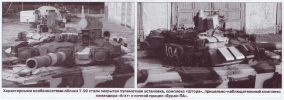
Kuvan tekstin käännös:
The characteristic features of the T-90's appearance were a closed machine gun mount, the Shtora complex, and a sighting and observation system
commander "Agat" and night sight "Buran-PA".
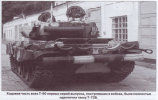
Kuvan tekstin käännös:
The chassis of all T-90s of the first production series that entered service with the troops was completely identical to the T-72B tank.
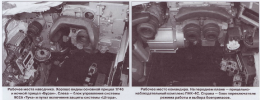
Vasemman kuvan tekstin käännös:
Gunner's workplace. The main 1G46 sight and the Buran night sight are clearly visible. On the left is the control unit of the 902A "Cloud" system and the remote control for turning on the protection of the "Curtain" system.
Oikean kuvan tekstin käännös:
Commander's workplace. In the foreground is the PNK-4S sighting and observation system. On the right is the operating mode switch and ammunition selection block.
-
Lähdeluettelon konekäännös englanniksi:
Literature and sources
1. Kolmakov D.G. Time. People. Tanks. Urals- The transport engineering design bureau is 60 years old. - N. Tagil, 2001. P.64.
2. Improved T-72B tank. Technical description 188.TO. Book 1. 1989.
3. Kolmakov D.G. Decree soch P. 65-67.
4. Shpak M.T. Fifty years of work at the Ural Carriage Works (1950-2000). Manuscript. Museum funds of JSC NPK Uralvagonzavod.
5. Yamov V.A. Armored vehicles. Part 1. MBT T-90S. Advertising edition. - N. Tagil; Tank gun 2А46М (2А46М-1). Advertising brochure for State Unitary Enterprise "Artillery Plant No. 9". 1999-2000; 125 mm tank guns 2A46M and 2A46M-1. Technical description and operating instructions. M., 1984. -
6. Koshchavtsev A. T-90 - Russian MBT // Tankmaster. 1998, No. 4-6; Electronic remote-contact fuse "Ainet-M". Advertising prospectus of the State Unitary Enterprise “Research Institute “Poisk”.
7. Product 188. Operating instructions 188.IE-1. - N. Tagil, 1996.
8. Yamov V.A. Op. op.
9. Yamov V.A. Decree. op.; Product 188. Operating instructions 188.IE-1. - N. Tagil, 1996.
10. Shpak M.T. Op. op.
11. Yamov V.A. Op.cit.; Tank T-72B. Technical description and operating instructions. M., 1995.
12. James M. Warford The Russian T-90S: Coming into Focus // ARMOR. 1997, September-October.
13.
http://www.niistali.ru/pr_secure/br_dz_inside.htm
14. Koshchavtsev A. Decree. op.
15. Koshchavtsev A. Decree. op.
16. Yuri Avdeev. “Motor locomotive” and “Mustang” in one harness // Krasnaya Zvezda. - 2005, November 19.
17. 38NIIII Ministry of Defense of Russia. 75 years of research and testing of armored weapons and equipment / Ed. Fedoty V.I. - Kubinka, 2006.
18. Yamov V.A. Decree. op.
19. Kolmakov D.G. Decree soch Q.67.
-
Lähdeluettelo venäjäksi:
Продолжение следует Литература и источники
1. Колмаков Д.Г. Время. Люди. Танки. Уральскому конструкторскому бюро транспортного машиностроения - 60 лет. - Н. Тагил, 2001. С.64.
2. Усовершенствованный танк Т-72Б. Техническое описание 188. ТО. Кн. 1. 1989.
3. Колмаков Д.Г. Указ Соч С. 65-67.
4. Шпак М.Т. Пятьдесят лет работы на Уральском вагоностроительном (1950-2000 годы). Рукопись. Фонды музея ОАО «НПК «Уралвагонзавод».
5. Ямов В.А. Бронетанковая техника. Ч.1. ОБТ Т-90С. Рекламное издание. - Н. Тагил; Танковая пушка 2А46М (2А46М-1). Рекламный проспект ГУП «Артиллерийский завод №9». 1999-2000 г.; 125-мм танковые пушки 2А46М и 2А46М-1. Техническое описание и инструкция по эксплуатации. М., 1984.
6. Кощавцев А. Т-90 - Российский ОБТ// Танкомастер. 1998, №4-6; Электронный дистан - ционно-контактный взрыватель «Айнет-М». Рекламный проспект ГУП «НИИ «Поиск».
7. Изделие 188. Инструкция по эксплуатации 188.ИЭ-1. - Н. Тагил, 1996.
8. Ямов В.А. Указ.соч.
9. Ямов В.А. Указ. соч.; Изделие 188. Инструкция по эксплуатации 188.ИЭ-1. - Н. Тагил, 1996.
10. Шпак М.Т. Указ.соч.
11. Ямов В.А. Указ.соч.; Танк Т-72Б. Техническое описание и инструкция по эксплуатации. М., 1995.
12. Джеймс М. Уорфорд Российские Т-90С: в центре внимания // БРОНЯ. 1997 год, сентябрь-октябрь.
13.
http://www.niistali.ru/pr_secure/br_dz_inside.htm
14. Кощавцев А. Указ. соч.
15. Кощавцев А. Указ.соч.
16. Юрий Авдеев. «Мотовоз» и «Мустанг» в одной упряжке // Красная Звезда. - 2005, 19 ноября.
17. 38НИИИ Минобороны России. 75 лет исследований и испытаний бронетанкового вооружения и техники / Под ред. Федоты В.И. - Кубинка, 2006.
18. Ямов В.А. Указ. соч.
19. Колмаков Д.Г. Указ Соч Вопрос 67.


